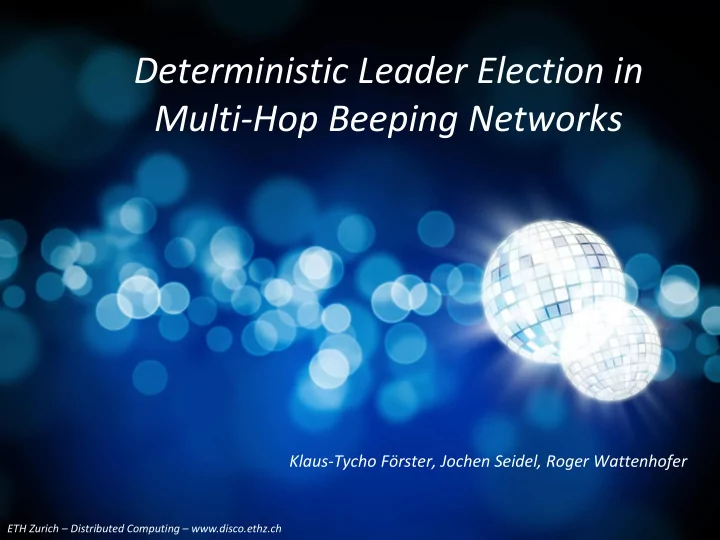

Deterministic Leader Election in Multi-Hop Beeping Networks Klaus-Tycho Förster, Jochen Seidel, Roger Wattenhofer ETH Zurich – Distributed Computing – www.disco.ethz.ch
What Algorithm to take? Deterministic Randomization Heuristic
Leader Election
LeaderElection Leader
Why deterministic leader election?
Why deterministic leader election?
Leader Election – Wireless Radio Networks Single-Hop • from Θ log log 𝑜 [Willard, 1986] to Θ 𝑜 log 𝑜 [Clementi et al., 2003] … – (depending on the model) Multi-Hop • with collision detection – (deterministic): Θ 𝑜 [Kowalski & Pelc, 2009] • without collision detection – (randomized): O 𝑜 log 𝑜 [Czumaj & Rytter, 2006] , Θ 𝑜 [Chlebus et al., 2012] – (deterministic): O 𝑜 log 3/2 𝑜 log log 𝑜 [Chlebus et al., 2012] – Ω 𝑜 log 𝑜 [Kowalski & Pelc, 2009] – O 𝑜 log 2 𝑜 log log 𝑜 [Vaya, 2011]
The Beeping Model • Each round: beep or listen • Listen: silence or beep (at least one neighbor beeps)
The Beeping Model Listen Listen Beep Listen • Each round: beep or listen • Listen: silence or beep (at least one neighbor beeps)
The Beeping Model Listens: Silence Listens: Beep Beep Listens: Beep • Each round: beep or listen • Listen: silence or beep (at least one neighbor beeps)
The Beeping Model Listen Listen Beep Beep • Each round: beep or listen • Listen: silence or beep (at least one neighbor beeps)
The Beeping Model Listens: Beep Listens: Beep Beep Beep • Each round: beep or listen • Listen: silence or beep (at least one neighbor beeps)
Leader Election – in the Beeping Model • Randomized: [Ghaffari & Haeupler, 2013] – 𝑃 𝐸 + log 𝑜 log log 𝑜 ∗ 𝑛𝑗𝑜 log log 𝑜 , log 𝑜 /𝐸
Deterministic Leader Election – in the Beeping Model 1110 1010 1101 1100 • Deterministic & Uniform: 𝑃 𝐸 log 𝑜 [this paper]
Deterministic Leader Election – in the Beeping Model 1 110 1 010 1 101 1 100
Deterministic Leader Election – in the Beeping Model 1 1 10 1 0 10 1 1 01 1 1 00
Deterministic Leader Election – in the Beeping Model 11 1 0 1010 11 0 1 11 0 0
Deterministic Leader Election – in the Beeping Model 111 0 1010 110 1 1100
Deterministic Leader Election – in the Beeping Model 1110 1111 1010 1101 1100 1111
Multi-Hop Beeping Model Not sending Listening Winner
But what about Uniformity? I know nothing ( I‘m Jon Snow)
IDs of different length? 111 10 1100 11 1 10...01 "∞"
IDs of different length? 111 10 1100 11 1 10...01 "∞"
IDs of different length? 111 10 1100 11 1 10...01 "∞"
IDs of different length? 1100 10 1100 11 1 10...01 "∞"
IDs of different length? 1100 1100 1100 11 1 10...01 "∞"
IDs of different length? 1100 1100 1100 1100 10...01 "∞"
IDs of different length? 111 10 1100 11 1 10...01 "∞" 1. Iteration running 1. Iteration done
IDs of different length? 111 10 1100 11 1 10...01 "∞" 1. Iteration running 1. Iteration done
IDs of different length? But I am still in I want to start with Iteration 1! Iteration 2! 111 10 1100 11 1 10...01 "∞" 1. Iteration running 1. Iteration done
IDs of different length? Iteration 𝑛𝑝𝑒 3 = 0 ? LISTEN Iteration 𝑛𝑝𝑒 3 = 0 ? LISTEN Iteration 𝑛𝑝𝑒 3 = 1 ? BEEP Iteration 𝑛𝑝𝑒 3 = 1 ? LISTEN Iteration 𝑛𝑝𝑒 3 = 2 ? LISTEN Iteration 𝑛𝑝𝑒 3 = 2 ? BEEP 111 10 1100 11 1 10...01 "∞" 1. Iteration running 1. Iteration done
Quiescence? Repeat the campaigning process 𝐸 times -> 𝑃 𝐸 log 𝑜 • • But how big is 𝐸 ? • How do we stop?
Quiescence? Solution: Overlay Onion Network
Conclusion • Multi-Hop Leader Election in the Beeping Model – 𝑃 𝐸 log 𝑜 rounds – Deterministic – Uniform – Quiescent • Combines – a local campaigning algorithm – a technique to sequentially execute algorithms – an overlay onion network
Deterministic Leader Election in Multi-Hop Beeping Networks Klaus-Tycho Förster, Jochen Seidel, Roger Wattenhofer ETH Zurich – Distributed Computing – www.disco.ethz.ch
Recommend
More recommend